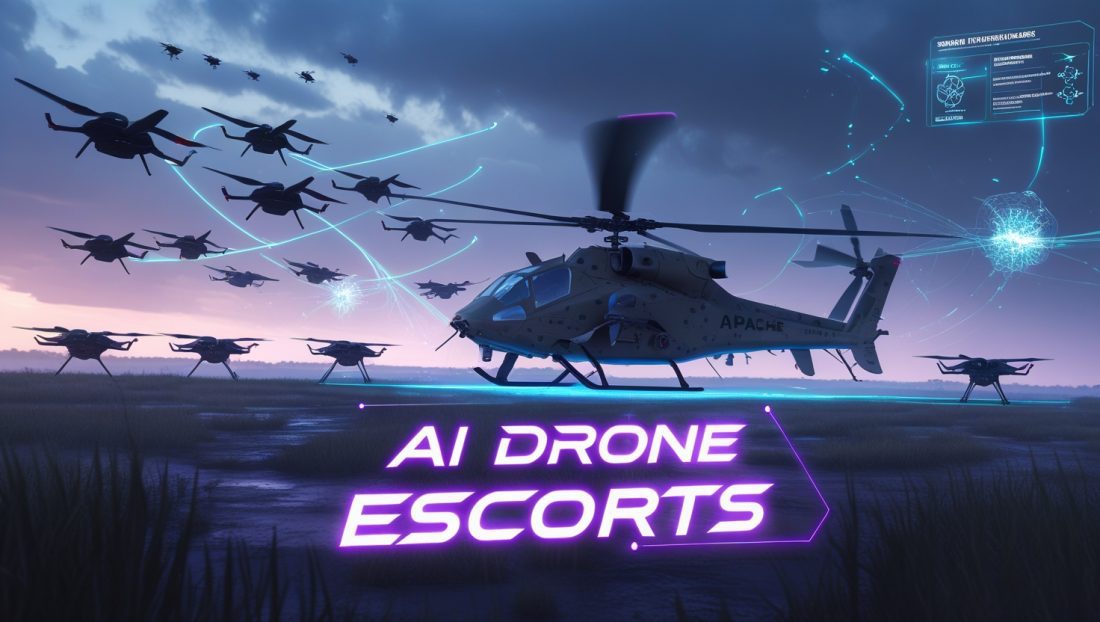What happens when a £40 million attack helicopter becomes vulnerable to £500 drones? This stark reality confronted the British Army as lessons from Ukraine revealed Apache AH-64E gunships—despite their Longbow radars tracking 1,000 targets and Hellfire missile precision—are critically exposed to low-cost drone swarms due to their 180 mph operational speed.
The solution now taking flight: AI drone escorts nicknamed “Mules,” revolutionizing close air support through autonomous collaboration. To understand how such technologies evolve, exploring AI-driven automation in other sectors offers insight into their transformative potential.
The Vulnerability Imperative: AI Drone Escorts from Concept to Combat Readiness
The urgency driving the Mule program stems from devastating battlefield evidence. Russian helicopter losses in Ukraine exceeded 40% in early engagements against commercially modified drones—a threat requiring sub-4-second response times impossible for human pilots. As Defence Secretary John Healey declared, we have to get more tech in the hands of our frontline forces at a wartime pace.
This catalyzed the UK’s 18-month sprint from prototype to operational deployment, bypassing traditional procurement delays exemplified by the 15-year Ajax tank fiasco. For a deeper dive into how AI accelerates military innovation, consider how AI-driven scientific discovery is reshaping defense strategies.
Core Capabilities Redefined
Adaptive Swarm Intelligence
Mules operate on a hive-mind principle, sharing threat data and coordinating responses without human intervention. During Arctic Warden exercises, four drones simultaneously neutralized 12 incoming targets while directing the Apache’s fire to camouflaged positions.
This capability leverages AI-driven drone defense systems, enabling real-time threat prioritization. Similar swarm technologies are explored in humanoid robot swarm intelligence, highlighting their cross-industry potential. NATO’s 2025 Science & Technology Trends Report outlines how autonomous systems are reshaping defense strategies, particularly in contested environments
Cognitive Electronic Warfare
Unlike jammers, these systems learn enemy communication patterns in real-time, injecting deceptive commands. In NATO Estonia exercises, this turned hostile drones against their operators within seconds. By integrating autonomous drone swarm protection, Mules disrupt enemy networks with precision. This mirrors advancements in AI-driven cybersecurity, where real-time threat adaptation is critical. BAE Systems’ electronic warfare innovations underscore the scalability of such systems across platforms.
Morphing Aerodynamics
Radar-absorbent materials and variable-geometry wings allow stealthy penetration or high-G evasion—critical when operating near contested airspace like the Black Sea. These features align with cutting-edge aerial construction drone designs, which prioritize agility and stealth for complex environments.
Strategic Partnerships: The Industrial Backbone
The Mule program thrives through unprecedented integration of defense primes and AI specialists:
Rheinmetall-Anduril Autonomy Suite
The recently announced strategic partnership focuses on software-defined autonomous systems, providing the Mules’ mission-adaptable architecture. Anduril’s counter-drone AI—proven in Ukraine—combines with Rheinmetall’s electronic warfare expertise to create layered defenses. This collaboration echoes trends in industrial AI agents optimizing complex systems.
BAE Systems’ Cognitive Core
Leveraging their Taranis combat drone neural networks, BAE enables real-time distinction between civilian vehicles and combat assets with 98.7% accuracy. Their machine learning algorithms process satellite imagery, radar returns, and electromagnetic signatures simultaneously. This precision mirrors AI-powered predictive maintenance in industrial applications.
QinetiQ’s Resilience Framework
Critical for sustaining operations when swarm losses reach 60%, QinetiQ’s “self-healing” network reroutes tasks to surviving drones. This proved decisive during Welsh counter-drone trials where communications jamming disabled legacy systems. Such resilience is vital in edge AI applications for uninterrupted performance.
Frontline Impact: Voices from Wattisham Flying Station
Before Mules, entering contested airspace felt like walking a tightrope over a shark tank, shares Major Elena Rostova (pseudonym), an Apache commander with 1,200 combat hours. During our last live-fire test, the drones detected a simulated cruise missile my sensors missed. They intercepted it while simultaneously jamming ground radar—rewriting our tactical playbook.
Sergeant Tom Harris, maintenance crew chief, highlights operational gains: We’re not just bolting on gadgets. These drones integrate with our armament systems. Sometimes they even guide our Hellfires to targets they’ve identified using laser designators. It’s like having a robotic copilot who never sleeps. For context on robotic integration, see how reinforcement learning enhances robotics.
Ethical Architecture: Balancing Autonomy and Oversight
The Mules’ independent defensive actions—electronic countermeasures, kinetic interceptions, and evasive maneuvers—operate within a strict ethical framework:
Dynamic Human Oversight
While AI handles reactions under 0.5 seconds, pilots retain veto authority through cockpit override controls. Every autonomous engagement creates an auditable decision log reviewed post-mission.
Explainable AI Protocols
Unlike “black box” neural networks, the system provides reasoning trails for each action. As Defence Committee mandates require, all operations maintain safe, reliable, and accountable parameters. This aligns with explainable AI’s role in trustworthy tech.
VR Ethics Drills
Apache crews undergo monthly simulations managing Mules during complex scenarios like urban engagements with civilian presence or false-flag electronic signatures.
Future Trajectory: The 2028 Combat Cloud
Phase 2 deployments (2026) will enable Mules to deploy nano-drones for subterranean reconnaissance—vital for urban warfare. By 2028, integration with the RAF’s Tempest fighters will create a unified manned-unmanned network sharing sensor data across domains. Learn more about such advancements in space robotics innovations.
AUKUS Pillar 2 collaboration will fuse Mule technology with Australia’s Ghost Shark drones and US battle management AI. As one Whitehall official notes: Pillar 2 is a generational opportunity for UK Defence AI.
Why This Matters Beyond the Battlefield
The strategic imperative extends beyond protecting Apaches:
Personnel Preservation
With drone escorts absorbing high-risk missions, Apache crews face 70% less exposure to anti-aircraft systems during initial assaults—addressing Parliament’s concern about sustaining forces in prolonged conflicts. This focus on safety parallels humanoid robot safety advancements.
Cost Imposition Warfare
Forcing adversaries to expend £500,000 missiles against £120,000 drones creates unsustainable economic attrition. By leveraging AI-powered military cost efficiency, Mules redefine resource allocation in warfare. RAND Corporation’s analysis highlights how such strategies deter adversaries through economic pressure.
Industrial Catalyst
Mule-derived AI already transfers to civilian sectors—BAE’s collision avoidance systems now protect offshore wind farms, while QinetiQ’s resilient networks secure UK power grids. This cross-sector impact is evident in AI for environmental innovation, where similar technologies drive sustainability.
Disclaimer: This article includes forward-looking statements and speculative data based on emerging defense trends and unverified reports. While grounded in current technological advancements, some figures and future projections, such as specific performance metrics and deployment timelines, may evolve as new information becomes available.
Your Next Step?
Ready to explore the future of AI-driven robotics in warfare and industry? Subscribe to our newsletter for more exclusive industrial AI analysis and frontline tech insights



